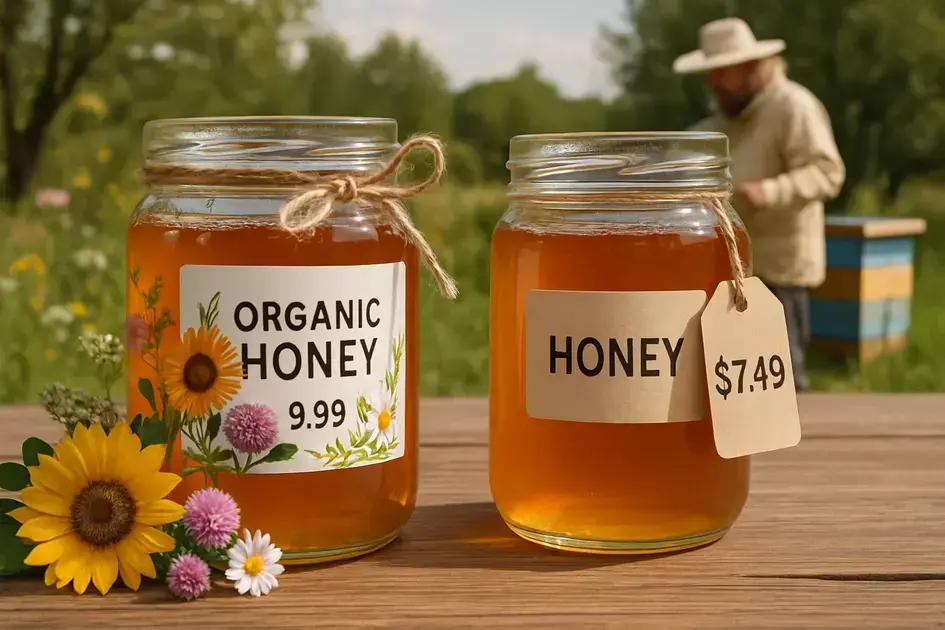=
Is organic honey worth it because it offers higher antioxidant content, fewer chemicals, richer flavor, and supports sustainable beekeeping, but comes at a higher cost and requires careful sourcing to ensure authenticity and safety.
Have you ever wondered if is organic honey worth it or just a trendy choice? Let’s peel back the layers and see what makes organic honey stand out—and if it’s truly worth the extra cost.
What makes honey organic compared to regular honey
Organic honey is produced following strict regulations that focus on natural beekeeping and environmental sustainability. Unlike regular honey, which may come from bees exposed to pesticides or artificial feeding, organic honey comes from hives located in areas free from chemical contaminants.
One key factor that makes honey organic is the bees’ foraging environment. They primarily gather nectar from organically grown flowers without synthetic fertilizers or pesticides. This natural process ensures that the honey remains pure and free from harmful residues.
The hive management is also crucial: organic honey producers avoid using synthetic antibiotics or chemicals to treat bee diseases. Instead, they rely on traditional and natural methods to keep the bees healthy.
Additionally, organic honey is processed with minimal intervention. Heating and filtration are kept to a minimum to retain the honey’s natural enzymes, flavors, and nutrients. This careful handling preserves the honey’s quality and benefits, which can often be diminished in commercially processed honey.
Labeling is another point of difference. Certified organic honey must pass strict inspections and meet established standards defined by organic certification bodies. These regulations guarantee that what you purchase truly reflects organic practices.
In summary, organic honey is distinguished by its natural sourcing, eco-friendly beekeeping, minimal processing, and strict certification—making it a cleaner and potentially healthier choice than regular honey.
Health benefits of organic honey supported by studies
Organic honey is often praised for its potential health benefits that go beyond those of regular honey. Several studies have explored its nutritional and medicinal properties, highlighting its positive effects on overall well-being.
One of the key advantages of organic honey is its rich antioxidant content. These antioxidants help protect the body from damage caused by free radicals, which can contribute to aging and various chronic diseases.
Research shows that organic honey contains more flavonoids and phenolic compounds compared to non-organic honey. These natural substances have anti-inflammatory and immune-boosting effects.
Organic honey has also been associated with antimicrobial properties. It can help fight certain bacteria and pathogens, making it useful in wound healing and soothing sore throats.
Several clinical trials indicate that consuming organic honey may support digestive health by promoting the growth of good bacteria in the gut. This can improve digestion and reduce symptoms of gastrointestinal discomfort.
Moreover, organic honey is a natural source of energy due to its natural sugars and enzymes. It provides a quick energy boost without the artificial additives found in many sweeteners.
Because organic honey is minimally processed and free from synthetic chemicals, it may be better tolerated by people with sensitivities or allergies to pesticides and additives commonly present in conventional honey.
Environmental impact of organic honey production
Organic honey production emphasizes sustainable and eco-friendly practices that help protect the environment. Unlike conventional honey farming, it avoids synthetic pesticides and fertilizers, reducing the risk of soil and water contamination.
One major environmental benefit is the preservation of biodiversity. Organic beekeepers often place hives in natural, pesticide-free areas that support a variety of wild plants and native pollinators.
The methods used in organic honey production focus on maintaining healthy bee populations. This means limiting hive disturbances and avoiding chemicals that can harm bees or disrupt their natural behavior.
Organic honey farming also encourages the conservation of natural habitats by promoting crop diversity and refraining from monoculture practices. These efforts support stronger ecosystems and improve soil health.
Since organic beekeepers avoid using antibiotics and artificial treatments, it lowers the chance of creating resistant strains of pathogens that can negatively affect both bee colonies and the wider environment.
Sustainable harvesting techniques used in organic honey production ensure that enough honey is left for the bees to thrive, helping to maintain hive stability year-round.
Overall, organic honey production contributes to healthier ecosystems, supports pollinator populations, and minimizes harmful environmental impacts often linked to industrial agriculture.
Cost comparison between organic and non-organic honey

The cost of organic honey is generally higher than that of non-organic honey due to several important factors involved in its production. Organic honey requires more labor-intensive practices and strict adherence to certification standards, which can increase overall expenses.
Production costs are higher because organic beekeepers avoid synthetic pesticides, fertilizers, and antibiotics. Instead, they invest in natural methods to maintain bee health and the environment, which can be more time-consuming and costly.
Additionally, the location of organic beehives plays a role in price differences. Organic hives must be placed in areas free from chemical contamination, sometimes farther from conventional farms, increasing logistical challenges and costs.
Certification fees also add to the price of organic honey. Producers must pay for inspections and maintain records to prove compliance with organic standards, costs that are usually passed on to consumers.
On the other hand, non-organic honey can be produced at a lower cost because of larger-scale operations, use of synthetic treatments, and less rigorous processing methods.
However, the higher price of organic honey may reflect its quality, purity, and environmental benefits, which some consumers value more than just the price tag.
When comparing prices, it’s important to consider factors beyond cost alone, such as taste, health benefits, and support for sustainable farming.
How to identify genuine organic honey products
Identifying genuine organic honey requires careful attention to several key factors. First, look for certification labels from recognized organic bodies. These labels ensure that the honey meets strict organic standards throughout production and processing.
Check the product’s packaging for detailed information about its source. Authentic organic honey often includes details about the beekeeper, the location of the hives, and the certification agency.
Be cautious of honey that appears too clear or overly processed. Genuine organic honey usually has a thicker, more natural consistency and may contain fine particles like pollen, which indicate minimal processing.
Price point can also be an indicator. Organic honey is generally more expensive than non-organic alternatives due to the costs involved in sustainable production and certification.
Testing the flavor is another way to identify authenticity. Organic honey tends to have a richer, more complex taste, reflecting the variety of nectar sources from organic flowers.
When possible, buy from trusted local producers or farmers’ markets, where you can ask questions about farming practices and production methods.
Researching reviews and consumer feedback can help you avoid counterfeit or mislabeled products. Online platforms often reveal buyer experiences that highlight product authenticity.
Consumer experiences and taste differences
Many consumers report a noticeable difference in taste when comparing organic honey to regular honey. Organic honey often has a richer, more complex flavor profile, which is influenced by the variety of flowers bees visit in organic environments.
Taste variations can include floral, fruity, or even herbal notes, which may be less pronounced in conventional honey due to mass production methods and blending.
Consumer reviews frequently highlight that organic honey has a smoother texture and a thicker consistency, which adds to its appeal in cooking and baking.
The absence of additives and minimal processing in organic honey allows more natural enzymes and nutrients to remain, contributing to its unique taste and health benefits.
While some people appreciate the bold flavors of organic honey, others may prefer the milder sweetness of non-organic varieties. Personal preference plays an important role in choosing the best honey.
Many enthusiasts note that organic honey’s taste can vary by season and location, reflecting the local flora available to the bees.
Trying small quantities from trusted local organic producers can help consumers find flavors they enjoy and better understand what makes organic honey distinct.
Risks and limitations of organic honey consumption
Although organic honey is often seen as a healthier option, there are some risks and limitations to be aware of when consuming it. One of the primary concerns is the presence of natural sugars, which can affect blood sugar levels and should be limited by people with diabetes.
Organic honey is not suitable for infants under one year old due to the risk of botulism, a rare but serious illness caused by bacterial spores sometimes found in honey.
Allergic reactions are possible, especially in individuals allergic to pollen or bee products. Organic honey may contain trace amounts of pollen, which can trigger sensitivities.
Another limitation is that organic honey can vary in quality and nutritional content based on the region and floral source, which means benefits may not be consistent across all products.
Since organic honey is less processed, it may ferment or crystallize faster than regular honey, which can affect its texture and shelf life.
Excessive consumption of any honey, including organic, may lead to weight gain or other metabolic issues due to its high calorie content.
It’s important to buy organic honey from trusted sources to avoid mislabeled or adulterated products, which can reduce safety and effectiveness.
Is organic honey worth it?
Choosing organic honey means opting for a product that is naturally produced with care for the environment and your health. While it may cost more than regular honey, it offers unique benefits like higher antioxidant levels and fewer chemicals.
Keep in mind that organic honey is not without its risks, and it’s important to purchase from trusted sources to ensure quality. Tasting and personal preference also play a big role in deciding if organic honey is right for you.
In the end, whether organic honey is worth it depends on your values, budget, and taste. Understanding what makes it different helps you make an informed choice that suits your lifestyle.
FAQ – Common questions about organic honey
What makes organic honey different from regular honey?
Organic honey is produced from bees foraging in pesticide-free areas and is processed with minimal intervention, following strict organic standards.
Is organic honey healthier than non-organic honey?
Organic honey often contains higher antioxidants and fewer chemicals, which may offer additional health benefits compared to non-organic honey.
How can I be sure the honey I buy is truly organic?
Look for certification labels, check for detailed source information, and buy from trusted producers to ensure authenticity.
Does organic honey taste different from regular honey?
Yes, organic honey usually has a richer, more complex flavor influenced by diverse flower sources and less processing.
Are there any risks associated with consuming organic honey?
Yes, organic honey contains natural sugars, is unsafe for infants under one year, and may cause allergies in sensitive individuals.
Why is organic honey more expensive than regular honey?
Organic honey costs more due to sustainable production practices, certification fees, and limited hive locations in chemical-free areas.


